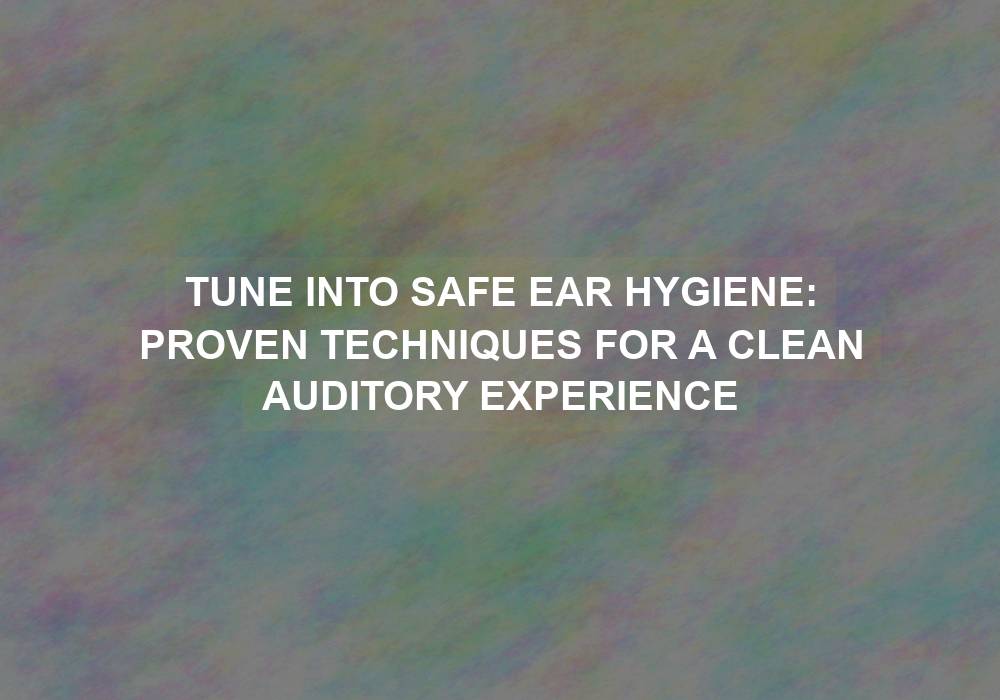The importance of maintaining good ear hygiene cannot be emphasized enough. Our ears play a vital role in our everyday lives, allowing us to communicate, appreciate music, and hear the world around us. However, without proper care, our ears can become susceptible to various infections, discomfort, and even hearing loss. This article aims to provide you with proven techniques for maintaining a clean auditory experience through safe ear hygiene practices.
Understanding the Ear Anatomy
Before delving into the techniques, it is crucial to understand the anatomy of the ear. The ear consists of three main parts: the outer ear, middle ear, and inner ear.
-
Outer Ear: The outer ear includes the visible part known as the pinna and the ear canal. The pinna acts as a funnel, directing sound waves into the ear canal. The ear canal, lined with tiny hairs and glands, produces earwax to protect and lubricate the ear.
-
Middle Ear: The middle ear houses the eardrum and three small bones called ossicles, which transmit sound vibrations. The eardrum is a thin membrane that vibrates when sound waves hit it, while the ossicles amplify and transmit these vibrations to the inner ear.
-
Inner Ear: Finally, the inner ear contains delicate structures responsible for converting sound vibrations into electrical signals that the brain can interpret. This includes the cochlea, a spiral-shaped organ filled with fluid and tiny hair cells that detect different frequencies of sound.
The Importance of Safe Ear Hygiene
Practicing safe ear hygiene is essential for maintaining the overall health and functionality of our ears. Here are some key reasons why safe ear hygiene is crucial:
-
Preventing Ear Infections: Clean ears are less likely to develop infections, such as swimmer’s ear or otitis media. These infections can cause pain, inflammation, and temporary hearing loss. To prevent infections, it’s important to keep the ears clean and dry, as moisture can create a breeding ground for bacteria or fungi.
-
Avoiding Wax Buildup: Earwax, also known as cerumen, is a natural substance produced by the ear to protect and lubricate the ear canal. However, excessive wax buildup can lead to discomfort, impaired hearing, and even tinnitus (ringing in the ears). Regular gentle cleaning of the outer ear can help prevent wax buildup. If excessive wax accumulates, it’s advisable to consult a healthcare professional for safe removal.
-
Protecting the Eardrum: Improper ear hygiene practices, such as using sharp objects or cotton swabs to clean the ears, can damage the delicate eardrum. A perforated eardrum can result in hearing loss and other complications. It’s important to avoid inserting anything into the ear canal and seek professional help if there’s an obstruction or excessive wax.
-
Maintaining a Clean Auditory Experience: Regular ear hygiene ensures optimal sound transmission, allowing us to fully enjoy the richness of the auditory experience. By keeping the ears clean and free from blockages, we can enhance our ability to hear and appreciate the world around us.
Proven Techniques for Safe Ear Hygiene
-
Gentle Cleaning: The outer ear and the ear canal should be cleaned regularly to remove dirt, dust, and excess earwax. Use a damp washcloth or a gentle, non-abrasive ear cleaning solution to wipe the outer ear. Avoid inserting anything into the ear canal, as this can push wax deeper or damage the eardrum. Gentle cleaning helps maintain a healthy ear environment and prevents wax buildup.
-
Avoid Cotton Swabs: Contrary to popular belief, cotton swabs should not be used for cleaning the ears. They can push earwax further into the ear canal, causing blockages or damage. Instead, let the earwax naturally migrate out of the ear, or consult a healthcare professional if you experience excessive wax buildup.
-
Dry Ears Thoroughly: After swimming or bathing, make sure to dry your ears thoroughly. Excess moisture in the ear canal can create a conducive environment for bacterial or fungal growth, leading to infections. Use a towel or a hairdryer set on low heat, maintaining a safe distance from the ear. Tilt your head to each side to allow water to drain from the ear canal.
-
Protect Against Excessive Noise: Prolonged exposure to loud noises can damage the delicate structures of the inner ear, resulting in permanent hearing loss. When exposed to loud environments, such as concerts or construction sites, wear earplugs or earmuffs to protect your ears. These protective devices help reduce the intensity of sound and preserve your hearing.
-
Avoid Inserting Foreign Objects: It is crucial to avoid inserting any foreign objects into the ear canal, such as bobby pins, pen caps, or toothpicks. These objects can cause injury, perforate the eardrum, or push debris further into the ear, leading to complications. If there’s an obstruction or discomfort in the ear, consult a healthcare professional for safe removal.
-
Regular Check-ups: Schedule regular check-ups with an audiologist or an ear, nose, and throat specialist to monitor your ear health. They can perform professional cleaning if necessary and detect any potential issues early on. Regular check-ups help ensure the early detection and treatment of any ear problems, preventing further complications.
-
Ear Care for Children: Children require special attention when it comes to ear hygiene. Teach them the importance of gentle cleaning and discourage them from inserting objects into their ears. If you suspect any ear issues, seek professional advice promptly. Children’s ears are more susceptible to infections, and early intervention can prevent long-term complications.
Conclusion
Maintaining safe ear hygiene is essential for ensuring a clean auditory experience and preventing potential complications. By following the proven techniques mentioned above, you can promote healthy ears, reduce the risk of infections, and preserve your hearing ability for years to come. Remember, when it comes to ear care, gentle practices and regular check-ups are key. Your ears deserve the best care, so tune into safe ear hygiene and enjoy the wonders of sound with confidence.
This content is written in markdown format.
